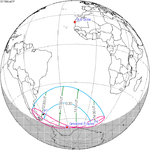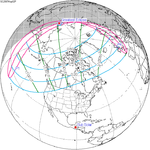Solar eclipse of January 14, 1907
| Solar eclipse of January 14, 1907 | |
|---|---|
| Type of eclipse | |
| Nature | Total |
| Gamma | 0.8628 |
| Magnitude | 1.0281 |
| Maximum eclipse | |
| Duration | 145 s (2 min 25 s) |
| Coordinates | 38°18′N 86°24′E / 38.3°N 86.4°E |
| Max. width of band | 189 km (117 mi) |
| Times (UTC) | |
| Greatest eclipse | 6:05:43 |
| References | |
| Saros | 120 (55 of 71) |
| Catalog # (SE5000) | 9297 |
A total solar eclipse occurred on January 14, 1907. A solar eclipse occurs when the Moon passes between Earth and the Sun, thereby totally or partly obscuring the image of the Sun for a viewer on Earth. A total solar eclipse occurs when the Moon's apparent diameter is larger than the Sun's, blocking all direct sunlight, turning day into darkness. Totality occurs in a narrow path across Earth's surface, with the partial solar eclipse visible over a surrounding region thousands of kilometres wide. Totality was visible from Russian Empire (the parts now belonging to Russia, Kazakhstan, Uzbekistan, Tajikistan and Kyrgyzstan) and China (now northwestern China, Mongolia and northern part of northeastern China).
Observations

Observations of the solar eclipse were made from the Tian Shan Mountains.[citation needed]
Related eclipses
Solar eclipses 1906–1909
This eclipse is a member of a semester series. An eclipse in a semester series of solar eclipses repeats approximately every 177 days and 4 hours (a semester) at alternating nodes of the Moon's orbit.[1]
The partial solar eclipses on February 23, 1906 and August 20, 1906 occur in the previous lunar year eclipse set.
| Solar eclipse series sets from 1906 to 1909 | ||||||
|---|---|---|---|---|---|---|
| Ascending node | Descending node | |||||
| Saros | Map | Gamma | Saros | Map | Gamma | |
| 115 | July 21, 1906 Partial |
−1.3637 | 120 | January 14, 1907 Total |
0.8628 | |
| 125 | July 10, 1907 Annular |
−0.6313 | 130 | January 3, 1908 Total |
0.1934 | |
| 135 | June 28, 1908 Annular |
0.1389 | 140 | December 23, 1908 Hybrid |
−0.4985 | |
| 145 | June 17, 1909 Hybrid |
0.8957 | 150 | December 12, 1909 Partial |
−1.2456 | |
Saros 120
This eclipse is a part of Saros series 120, repeating every 18 years, 11 days, and containing 71 events. The series started with a partial solar eclipse on May 27, 933 AD. It contains annular eclipses from August 11, 1059 through April 26, 1492; hybrid eclipses from May 8, 1510 through June 8, 1564; and total eclipses from June 20, 1582 through March 30, 2033. The series ends at member 71 as a partial eclipse on July 7, 2195. Its eclipses are tabulated in three columns; every third eclipse in the same column is one exeligmos apart, so they all cast shadows over approximately the same parts of the Earth.
The longest duration of annularity was produced by member 11 at 6 minutes, 24 seconds on September 11, 1113, and the longest duration of totality was produced by member 60 at 2 minutes, 50 seconds on March 9, 1997. All eclipses in this series occur at the Moon’s descending node of orbit.[2]
| Series members 50–71 occur between 1801 and 2195: | ||
|---|---|---|
| 50 | 51 | 52 |
 November 19, 1816 |
 November 30, 1834 |
 December 11, 1852 |
| 53 | 54 | 55 |
 December 22, 1870 |
 January 1, 1889 |
 January 14, 1907 |
| 56 | 57 | 58 |
 January 24, 1925 |
 February 4, 1943 |
 February 15, 1961 |
| 59 | 60 | 61 |
 February 26, 1979 |
 March 9, 1997 |
 March 20, 2015 |
| 62 | 63 | 64 |
 March 30, 2033 |
 April 11, 2051 |
 April 21, 2069 |
| 65 | 66 | 67 |
 May 2, 2087 |
 May 14, 2105 |
 May 25, 2123 |
| 68 | 69 | 70 |
 June 4, 2141 |
 June 16, 2159 |
 June 26, 2177 |
| 71 | ||
 July 7, 2195 | ||
See also
Notes
- ^ van Gent, R.H. "Solar- and Lunar-Eclipse Predictions from Antiquity to the Present". A Catalogue of Eclipse Cycles. Utrecht University. Retrieved 6 October 2018.
- ^ "NASA - Catalog of Solar Eclipses of Saros 120". eclipse.gsfc.nasa.gov.
References
- Earth visibility chart and eclipse statistics Eclipse Predictions by Fred Espenak, NASA/GSFC
- Photo of observations solar eclipse of January 14, 1907
- Solar eclipse of January 14, 1907 in Russia
- Solar eclipse of January 14, 1907




